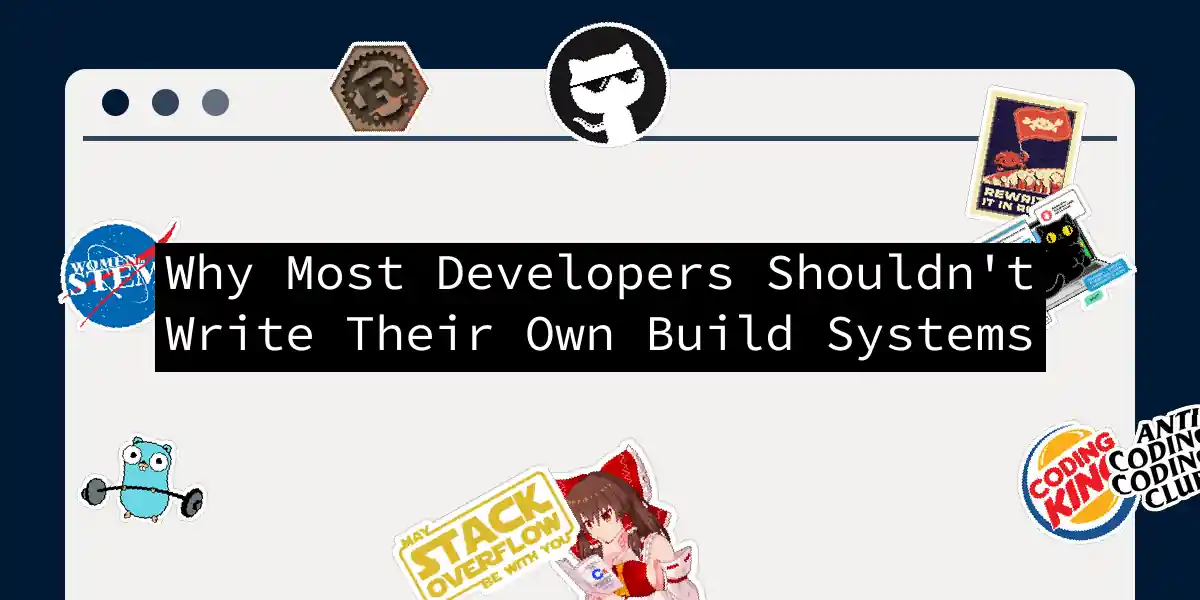Ah, the siren song of the custom build system! It whispers: “You’re special, your project is unique, and only you can craft the perfect build tool.” It’s the developer equivalent of hiking Mount Everest because the staircase at home feels inadequate. Before you embark on this noble quest, let me share why you might want to reconsider that expedition 🧭.
The Build System Trap: Why DIY Isn’t Always Better
Picture this: You’re baking cookies 🍪. Do you:
- A) Use a reliable oven with temperature controls
- B) Forge your own kiln from backyard clay This is the build system dilemma! While crafting your own feels empowering (“I made this!”), it often becomes a resource-sucking dragon. Here’s why:
- The Never-Ending Maintenance Goblin
Your custom system needs constant feeding:Every new requirement births a new maintenance burden. Off-the-shelf systems? They handle edge cases while you sip coffee.# Your "simple" build script over time v1: ./build.sh v2: ./build.sh --env=prod v3: ./build.sh --env=prod --target=arm64 --coverage v4: [500 lines of bash later] 💀 - The “It Works on My Machine” Avalanche
Custom build tools become snowflakes ❄️ – unique and fragile. When:- CI fails mysteriously
- New hire’s setup explodes
- macOS update breaks everything
…you’ll wish you’d used battle-tested tools.
- Innovation’s Silent Killer
Time spent wrestling with build pipelines is time not spent:graph LR A[Custom Build System] --> B{20 hours/week} B --> C[Marginal improvements] B --> D[Zero new features]Your competitors using standard tools? They’re shipping features while you debug incremental compilation.
When You Should Build: The 1% Exception
There are valid cases – if you’re:
- Google scaling to billions of builds/day
- Building embedded OS for Mars rovers
- Working with exotic hardware needing cosmic-ray fault detection
For the other 99%? Let’s explore better options.
The Rescue Path: Modern Build Solutions
Step 1: Adopt a Proven Build System
Here’s Bazel in action for a Python project:
# WORKSPACE
load("@bazel_tools//tools/build_defs/repo:http.bzl", "http_archive")
http_archive(
name = "rules_python",
sha256 = "a30abdf...",
url = "https://github.com/bazelbuild/rules_python/releases/download/0.8.1/rules_python-0.8.1.tar.gz",
)
# BUILD
load("@rules_python//python:defs.bzl", "py_binary")
py_binary(
name = "my_app",
srcs = ["main.py"],
deps = ["//lib:my_lib"],
)
Key advantages:
- Hermetic builds (no more “works on my machine”)
- Incremental builds that actually work
- Shared cache across teams
Step 2: Containerize Your Build Environment
Dockerfile build stage:
FROM python:3.11-slim as builder
RUN pip install --user poetry
COPY pyproject.toml .
RUN poetry export -f requirements.txt --output requirements.txt
FROM python:3.11-slim
COPY --from=builder requirements.txt .
RUN pip install -r requirements.txt
COPY . .
→ Eliminates environment drift permanently
Step 3: Leverage CI Magic
GitHub Actions configuration:
jobs:
build:
runs-on: ubuntu-latest
steps:
- uses: actions/checkout@v4
- uses: actions/setup-python@v4
with:
python-version: '3.11'
- run: pip install -r requirements.txt
- run: pytest
- uses: actions/upload-artifact@v3
with:
path: dist/*.whl
→ Free parallelism, caching, and cloud scaling
The Maintenance Calculus
Translation: That “simple” script will cost you 20x more long-term.
The Uncomfortable Truth
Building custom build systems is like hand-carving your own toothbrush – technically impressive, but rarely worth the effort. The giants (Bazel, Buck, CMake, Make, Gradle) have already:
- Solved cache invalidation properly
- Handled distributed builds
- Optimized for parallelism
- Created plugin ecosystems Your energy is better spent on problems that aren’t already solved by battle-tested tools. Now if you’ll excuse me, I need to go NOT rewrite my IDE from scratch… again. 🔧 What’s your build system horror story? Share below! ⬇️
